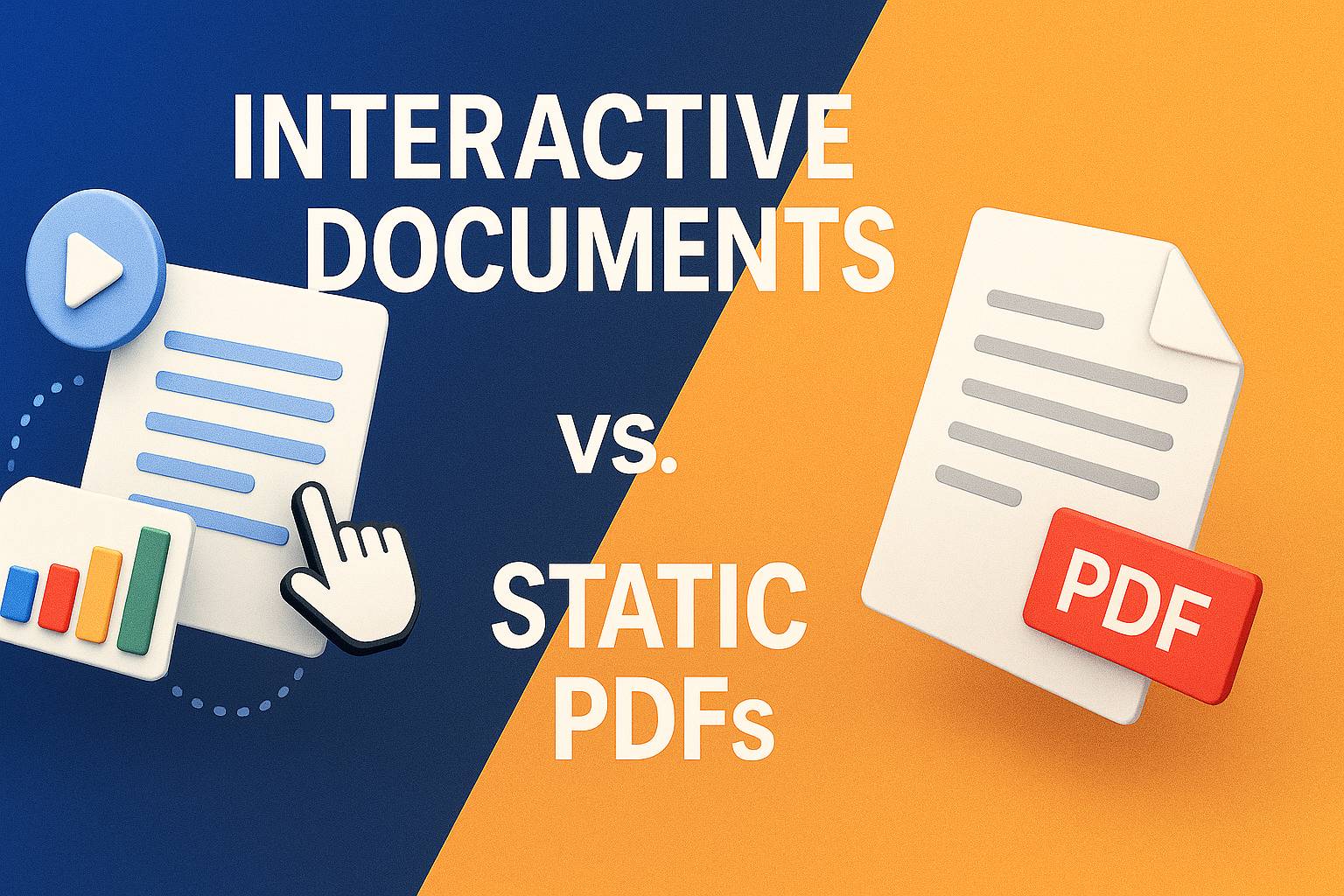tl;dr
- Static PDFs are outdated. They’re hard to track, low on engagement, and weak on conversions.
- Interactive documents combine video, narration, chat, and clickable elements to guide users and drive action.
- Platforms like Docustream.ai let you upload a PDF and turn it into an engaging, trackable experience in minutes.
- Interactive docs offer:
- Higher read time (4–6 minutes vs. 45 seconds)
- Higher CTA click rates (12–25%)
- Better mobile UX
- Actionable insights through built-in analytics
- They’re ideal for sales decks, HR onboarding, legal compliance, and product explainers.
- No tech skills needed. No more blind spots. Just smarter, clearer, conversion-ready communication.
No one wants to read a PDF anymore.
Whether it’s a 30-page product deck, an onboarding manual, or a compliance guide, the moment it lands in someone’s inbox as a static attachment… you’ve already lost them.
Not because the content is bad but because the format is broken.
PDFs are passive. They assume attention. They offer no feedback, no insight, no engagement loop.
In a world where people expect content to be clickable, scrollable, personalized, and even conversational, static PDFs are stuck in 1993.
Now compare that to interactive documents:
- They talk to your audience (sometimes literally).
- They highlight what matters in real-time.
- They collect feedback, guide decisions, and track every click.
And they convert.
In this article, we’ll break down why interactive docs dramatically outperform static PDFs not just in theory, but in cold, hard conversion data. You’ll see the behavioral science behind engagement, learn how enterprises are making the switch, and walk away with actionable steps to turn your old-school PDFs into high-performance content.
Let’s turn your documents from “download and ignore” into “click, engage, convert.”
The Problem With Static PDFs
For years, PDFs have been the go-to format for sharing important information (whitepapers, product catalogs, onboarding kits, investment decks, training manuals, etc.)
But in today’s digital environment, static PDFs are no longer pulling their weight.
Here’s why:
1. They’re Passive, Not Persuasive
A static PDF doesn’t guide your reader, it dumps information on them and hopes they care enough to scroll.
- No visual cues
- No interactivity
- No audio or video to keep attention
You’re relying on someone’s willpower to engage. And that’s a gamble.
2. Zero Insight Into Reader Behavior
With PDFs, you send it… and that’s it.
- Did they open it?
- Did they read it?
- Which section confused them?
- Where did they stop reading?
You’ll never know. And if your content isn’t driving conversions, you have no data to fix it.
3. High Cognitive Load = Drop Offs
PDFs often feel like homework.
- Dense formatting
- Long paragraphs
- No modular navigation
- Poor mobile experience
It’s no surprise that most recipients skim at best, ignore at worst. Every scroll requires effort, with no reward along the way.
4. Disconnected From Action
Most PDFs bury the CTA at the end, if they have one at all.
There’s no way to:
- Trigger a form mid-way
- Capture intent in real-time
- Launch a chatbot to answer a question
- Track who’s ready to buy or still confused
And that’s why static PDFs leak conversions like a broken funnel.
The Rise of Interactive Documents
If static PDFs are the equivalent of fax machines, then interactive documents are the smartphones of business communication.
They’re not just a visual upgrade. They’re a functional revolution in how content is delivered, consumed, and acted on.
What Are Interactive Documents?
Interactive docs go beyond text and static images. They combine elements of web, video, and apps into one unified experience (without requiring code).
Key features typically include:
- Clickable navigation (jump between sections instantly)
- Embedded videos or voiceovers synced to the content
- Live Q&A or chatbot functionality
- Quizzes, polls, and feedback forms
- Real-time document highlighting and animations
- Integrated analytics dashboards
In short: They make the document feel alive.
And platforms like Docustream.ai make it possible to turn a simple PDF or PowerPoint into a dynamic, guided experience in minutes.
Why They Work Better
People today don’t consume content linearly. They scroll, click, listen, skim, rewind, and ask.
Interactive docs are built for this reality. Here’s why they convert better:
- They guide attention instead of fighting for it
- They adapt to the reader, not the other way around
- They turn passive readers into active participants
The result? Higher engagement, better comprehension, and more action taken.
It’s not just a format shift, it’s a mindset shift. From dumping information to delivering a two-way experience.
6 Reasons Interactive Docs Drive More Conversions
If you’re wondering whether switching from static PDFs to interactive documents is worth the effort, the data says yes, and here’s why.
1. Higher Engagement Time
Interactive documents aren’t linear, they’re layered.
By combining voiceovers, synced animations, videos, and clickable elements, they hold attention far longer than a flat PDF ever could.
- Readers don’t just scroll, they watch, click, listen, and react
- Multi-sensory engagement can increase information retention by 65%
- Time-on-page can jump from seconds to minutes
Why it matters: More time = more trust = higher conversion potential.
2. Real Time Personalization
Modern interactive tools (like Docustream.ai) allow you to embed dynamic features:
- Live chatbot support inside the document
- Contextual Q&A that answers queries as they arise
- Adaptive navigation based on user interest
This creates a personalized experience at scale, without needing a sales rep on every page.
Personalized content drives 80% higher intent to convert, according to Salesforce.
3. Guided Navigation = Less Friction
PDFs expect users to find the CTA buried on page 17.
Interactive docs? They guide users toward key actions at the right time.
- Animated CTAs
- “Next step” nudges
- Jump links and callout boxes
- Mid-content sign-up forms
Why it matters: The less effort it takes to convert, the more likely users are to do it.
4. Built-In Analytics
Static PDFs give you… nothing.
Interactive docs show you:
- Who opened the document
- How long they spent on each section
- Which parts they skipped
- Where they dropped off
- Which CTA they clicked (if any)
Why it matters: You can fix what isn’t working, and double down on what is.
5. Seamless Follow-Ups
With integrations baked in, interactive documents don’t just engage, they connect directly to your funnel.
- Sync form fills with CRM tools
- Trigger email sequences from document activity
- Use heatmaps to segment users by behavior
Why it matters: You get warm leads without chasing ghost readers.
6. Better Mobile Experience
Let’s face it: PDFs are a nightmare on mobile.
Interactive documents are responsive by design:
- Text adjusts for readability
- Videos play inline
- Navigation feels like a modern web experience
Why it matters: Over 50% of document views now happen on mobile. Don’t lose them to poor UX.
Static PDF vs Interactive Doc: Conversion Metrics Breakdown
Still on the fence about switching? Let’s compare performance side by side.
These are real-world averages based on internal benchmarks, client case studies, and behavioral data across thousands of document interactions.
| Metric | Static PDF | Interactive Document |
|---|---|---|
| Average Read Time | 45 seconds | 4–6 minutes |
| CTA Click Rate | <2% | 12–25% |
| Conversion Rate | ~0.8% | 6–10% |
| Feedback Collected | None | Up to 40% response rate |
| Revisit/Replay Rate | Untracked | 18–30% |
| Mobile Experience Rating | Poor | Excellent |
| Actionable Analytics | No | Yes |
What the Data Says:
- Interactive docs hold attention 5x longer
- Readers are 10x more likely to take action when prompted at the right time
- You gain full visibility into how your content performs (section by section)
- Mobile users stay engaged rather than bouncing from clunky PDF formatting
In short, static PDFs are silent black boxes. Interactive documents are living systems that guide, respond, and convert.
How to Turn Your PDFs Into Interactive Experiences
You don’t need to start from scratch or hire a production team. Turning a static PDF into a high-performing interactive document is easier than ever, with the right tool.
See how to turn your PDFs into interactive documents on Docustream.ai here.
Final Thoughts
Static PDFs had their time, but that time is over.
In a digital world where attention is scarce and expectations are high, passive documents just don’t cut it anymore. They can’t guide the reader, can’t adapt to user behavior, and can’t show you what’s working.
Interactive documents, on the other hand, do all of that and more.
They:
- Captivate your audience with multi-sensory experiences
- Clarify your message through synced narration and visual guidance
- Convert readers into customers, team members, or informed stakeholders
And with platforms like Docustream.ai, you don’t need to reinvent your content. You just need to transform how it’s delivered.
So ask yourself:
Are your documents being read, or being ignored?
Because in 2025, attention is a currency, and interactive docs are how you earn it.













